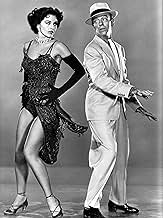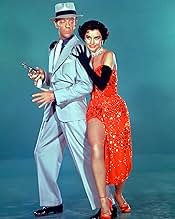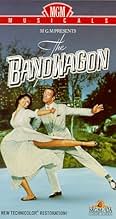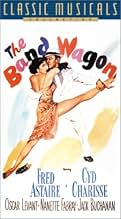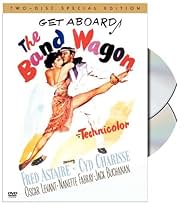VALUTAZIONE IMDb
7,4/10
13.219
LA TUA VALUTAZIONE
Un artistico e pretenzioso regista è assunto per un nuovo musical di Broadway, cambiandolo drasticamente.Un artistico e pretenzioso regista è assunto per un nuovo musical di Broadway, cambiandolo drasticamente.Un artistico e pretenzioso regista è assunto per un nuovo musical di Broadway, cambiandolo drasticamente.
- Regia
- Sceneggiatura
- Star
- Candidato a 3 Oscar
- 2 vittorie e 5 candidature totali
India Adams
- Gabrielle Gerard
- (voce (canto))
- (non citato nei titoli originali)
Fred Aldrich
- Hot Dog Vendor
- (non citato nei titoli originali)
Richard Alexander
- Stagehand
- (non citato nei titoli originali)
Ernest Anderson
- Train Porter
- (non citato nei titoli originali)
Barbara Bailey
- Dancer
- (non citato nei titoli originali)
Patsy Bangs
- Dancer
- (non citato nei titoli originali)
Lysa Baugher
- Dancer in Troupe
- (non citato nei titoli originali)
Mary Bayless
- Theatre Patron
- (non citato nei titoli originali)
Brandon Beach
- Auction Guest
- (non citato nei titoli originali)
Ralph Beaumont
- Dancer in Troupe
- (non citato nei titoli originali)
Don Beddoe
- Producer
- (non citato nei titoli originali)
Recensioni in evidenza
The Bandwagon may yet prove to be the best of backstage musicals. It certainly is Fred Astaire at his best, probably his best film when he did not partner with Ginger Rogers.
Arthur Freed had great success with two previous song catalog musicals, An American In Paris with the music of George Gershwin and Singing in the Rain which utilized the songs that he wrote with Nacio Herb Brown. His source for this film were the songs of Howard Dietz and Arthur Schwartz.
Dietz and Schwartz were an interesting pair of writers. Howard Dietz worked right at MGM in their publicity department. In fact it was Dietz who invented MGM's famous Leo the Lion. Song lyrics were in fact an avocation. Arthur Schwartz was a lawyer who just one day gave up the practice of law to devote himself to songwriting. They wrote some of the best music of the Thirties. After which Dietz devoted himself to publicizing MGM and Schwartz worked with other lyricists.
They wrote revues and this is where the source material for The Band Wagon comes from. In fact one of their revues was entitled The Band Wagon and starred none other than Fred and Adele Astaire. However the team got together again and wrote one new number for the film, the legendary That's Entertainment.
This The Band Wagon is not a revue. The plot concerns an aging musical film star Fred Astaire, talked into coming east by husband and wife writing team Nanette Fabray and Oscar Levant. They want him to do a Broadway show to revive his career. They get Broadway wunderkind Jack Buchanan to direct it and later on classical ballet star Cyd Charisse to team with Astaire.
Buchanan is outrageously funny as he first tries to get them to do an avant garde musical about the Faust saga. When that flops, he's a good enough trooper to put ego aside and do some serious rewriting. And this man certainly has one Texas size ego. According to a book on the Arthur Freed musicals, Buchanan was in a lot of pain from arthritis and doing some of those numbers, especially Triplets was agony for him.
That was not the only problem on the set. It was a pretty grim place. Oscar Levant had suffered a heart attack before the production and he was ten times his normal hypochondriac self. And Fred Astaire's wife was terminally ill at home.
Cyd Charisse gauging the mood of her fellow cast members just kept to herself, but Nanette Fabray who is an exuberant personality did not go over well as Miss Perky. She recorded it was one of her worst film experiences.
Still this monumental triumph of a film got made. My favorite of all the numbers besides That's Entertainment is the soft shoe duet that Fred Astaire and Jack Buchanan partner in. It's all grace and elegance and so typically Fred Astaire. And it's probably what most people know of Jack Buchanan. Over in the United Kingdom he was a leading stage and screen performer. Until The Band Wagon was made he was probably best known to American audiences as Jeanette MacDonald's leading man in Monte Carlo.
Cyd Charisse dances divinely as she always does, never better than in the finale, The Girl Hunt Ballet with Astaire. I still wonder why she never starred at MGM with her husband Tony Martin.
When one is asked what the American musical film ideal is, one of the best answers you can give is The Band Wagon.
Arthur Freed had great success with two previous song catalog musicals, An American In Paris with the music of George Gershwin and Singing in the Rain which utilized the songs that he wrote with Nacio Herb Brown. His source for this film were the songs of Howard Dietz and Arthur Schwartz.
Dietz and Schwartz were an interesting pair of writers. Howard Dietz worked right at MGM in their publicity department. In fact it was Dietz who invented MGM's famous Leo the Lion. Song lyrics were in fact an avocation. Arthur Schwartz was a lawyer who just one day gave up the practice of law to devote himself to songwriting. They wrote some of the best music of the Thirties. After which Dietz devoted himself to publicizing MGM and Schwartz worked with other lyricists.
They wrote revues and this is where the source material for The Band Wagon comes from. In fact one of their revues was entitled The Band Wagon and starred none other than Fred and Adele Astaire. However the team got together again and wrote one new number for the film, the legendary That's Entertainment.
This The Band Wagon is not a revue. The plot concerns an aging musical film star Fred Astaire, talked into coming east by husband and wife writing team Nanette Fabray and Oscar Levant. They want him to do a Broadway show to revive his career. They get Broadway wunderkind Jack Buchanan to direct it and later on classical ballet star Cyd Charisse to team with Astaire.
Buchanan is outrageously funny as he first tries to get them to do an avant garde musical about the Faust saga. When that flops, he's a good enough trooper to put ego aside and do some serious rewriting. And this man certainly has one Texas size ego. According to a book on the Arthur Freed musicals, Buchanan was in a lot of pain from arthritis and doing some of those numbers, especially Triplets was agony for him.
That was not the only problem on the set. It was a pretty grim place. Oscar Levant had suffered a heart attack before the production and he was ten times his normal hypochondriac self. And Fred Astaire's wife was terminally ill at home.
Cyd Charisse gauging the mood of her fellow cast members just kept to herself, but Nanette Fabray who is an exuberant personality did not go over well as Miss Perky. She recorded it was one of her worst film experiences.
Still this monumental triumph of a film got made. My favorite of all the numbers besides That's Entertainment is the soft shoe duet that Fred Astaire and Jack Buchanan partner in. It's all grace and elegance and so typically Fred Astaire. And it's probably what most people know of Jack Buchanan. Over in the United Kingdom he was a leading stage and screen performer. Until The Band Wagon was made he was probably best known to American audiences as Jeanette MacDonald's leading man in Monte Carlo.
Cyd Charisse dances divinely as she always does, never better than in the finale, The Girl Hunt Ballet with Astaire. I still wonder why she never starred at MGM with her husband Tony Martin.
When one is asked what the American musical film ideal is, one of the best answers you can give is The Band Wagon.
The Band Wagon is one of those films such as "The Maltese Falcon" and "Some Like It Hot", where just about everybody involved does the finest work of their career, both in front of and behind the camera. It is certainly the best collaboration between two legends of the musical genre, hoofer Fred Astaire and director Vincente Minnelli.
Astaire plays has-been Hollywood star Tony Hunter who hopes to revive his popularity by returning to Broadway in a new musical written by his friends Lester and Lily Marton (Oscar Levant and Nanette Fabray in essence portraying the screenplay's authors, Adolph Green and Betty Comden).
The Martons have entrusted the staging of their show to wunderkind actor/director/producer Jeffrey Cordova (a combination caricature of Orson Welles and Jose Ferrer played by British song-and-dance man Jack Buchanan). Two of Cordova's inspirations include casting ballerina Gabrielle Gerard (Charisse) as the female lead (good idea) and turning the show into a pretentious Faust allegory (really bad idea).
Tony and Gabrielle rub each other the wrong way - at first, and Cordova's joyless concoction lays an egg. But the cast vows to forge ahead and try again with another musical, this time with no mention of hell or the devil.
As clever as the script is, the main attractions are the exquisitely performed musical numbers (written by Arthur Schwartz and Howard Dietz) including "That's Entertainment", "A Shine on Your Shoes","Dancing in the Dark" and the greatest grand finale in the history of movie musicals "The Girl Hunt Ballet", a parody of film noir with Astaire as private eye Rod Riley and Charisse in a dual role as good girl and femme fatale.
Astaire plays has-been Hollywood star Tony Hunter who hopes to revive his popularity by returning to Broadway in a new musical written by his friends Lester and Lily Marton (Oscar Levant and Nanette Fabray in essence portraying the screenplay's authors, Adolph Green and Betty Comden).
The Martons have entrusted the staging of their show to wunderkind actor/director/producer Jeffrey Cordova (a combination caricature of Orson Welles and Jose Ferrer played by British song-and-dance man Jack Buchanan). Two of Cordova's inspirations include casting ballerina Gabrielle Gerard (Charisse) as the female lead (good idea) and turning the show into a pretentious Faust allegory (really bad idea).
Tony and Gabrielle rub each other the wrong way - at first, and Cordova's joyless concoction lays an egg. But the cast vows to forge ahead and try again with another musical, this time with no mention of hell or the devil.
As clever as the script is, the main attractions are the exquisitely performed musical numbers (written by Arthur Schwartz and Howard Dietz) including "That's Entertainment", "A Shine on Your Shoes","Dancing in the Dark" and the greatest grand finale in the history of movie musicals "The Girl Hunt Ballet", a parody of film noir with Astaire as private eye Rod Riley and Charisse in a dual role as good girl and femme fatale.
Stunning musical about fading star Fred Astaire making stage comeback with the help of friends Oscar Levant and Nanette Fabares. Jack Buchanon is fun as hammy stage actor who teams up with the group. Cyd joins in as haughty ballerina. The songs are first rate. Fred's solos and the girl hunt ballet are good but I prefer the romantic Dancing in the Dark number. The other highlight is Fred cheering up the cast after the first night flops.This was the film that introduced That's Entertainment. It is given a joyous presentation as Jack Buchanon explains what the job of show business is all about.The color is stunning,costumes great,set design good.Surprisingly Cyd's big solo "Two-faced Woman" was cut. It was shown on TCM.
Perhaps the finest hour of Fred Astaire and Cyd Charisse together (although Silk Stockings comes a close second); the 'Dancing in the Dark' sequence says it all about both this film, and the two impeccably classy stars.
There are, of course, other highlights - Oscar Levant and Nanette Fabray's acidic writers; Jack Buchanan's overblown producer; Fred's dance with the shoeshine boy, Le Roy Daniels; anything featuring Cyd Charisse - and those wonderful musical numbers, ranging from the anthem 'That's Entertainment' to the hilarious 'Triplets'.
'The Band Wagon' sends up the old film staple plot "putting on a show" and does it brilliantly, thanks to the crackling Comden/Green script. One of MGM's best musical efforts, hugely enjoyable.
There are, of course, other highlights - Oscar Levant and Nanette Fabray's acidic writers; Jack Buchanan's overblown producer; Fred's dance with the shoeshine boy, Le Roy Daniels; anything featuring Cyd Charisse - and those wonderful musical numbers, ranging from the anthem 'That's Entertainment' to the hilarious 'Triplets'.
'The Band Wagon' sends up the old film staple plot "putting on a show" and does it brilliantly, thanks to the crackling Comden/Green script. One of MGM's best musical efforts, hugely enjoyable.
MGM, Arthur Freed, Vincent Minelli, Betty Comden and Adolph Green, Fred Astaire, Cyd Charisse, Oscar Levant, Nanette Fabray, Jack Buchanan and that wonderful company behind them. Wow! The Broadway musical is one of America's great contributions to the performing arts, and the Band Wagon delightfully turns its clichés on their heads, with the story of a plucky group of troopers who put all their heart and talent into...a turkey.
Great dancing includes one of Fred Astaire's classic ballet duos, "Dancing in the Dark," with Cyd Charise. She does this spin ending in a semi-kneel, with the mid-calf hem of her dress landing mid-thigh, in order to display one of those spectacular gams of hers...'tis a wonder to behold! Also, there's a number with Astaire and Jack Buchanan, one of the great British variety stars. It's a delight to see this all-too-short exhibition of contrasting dance styles by two master hoofers.
And there's the added treat of Nanette Fabray and Oscar Levant (Levant being one those, like Robert Benchley, who entertains by playing himself) standing in for Comden and Green, who happened to write The Band Wagon (as well as Singin' in the Rain and Bells are Ringing). What I like about Comden and Green is, that while most all American musicals come out of New York, the sound of Comden and Green IS New York. They once said, "New York is the ongoing background of our lives - Brooklyn girl, Bronx boy - and whether we have been conscious of it or not, it is the background..."
Yes, there's the music - five numbers, part of the great repertory of American Standards: That's Entertainment, By Myself, You and the Night and the Music, Something to Remember You By, and of course Dancing in the Dark. My favorite dance number after DITD is Shine on My Shoes, surely an under-appreciated classic. All in all, a pretty good score (no pun intended), wouldn't you say?
The story is classified as a "backstage musical," and certainly it is. But there's a scene in Band Wagon with a truly documentary feel. After the show's premier, there's a dress-down cast party. The underpaid company singers and dancers really are in it for the love, and when they want to wind down, they go somewhere cozy, get their drinks and sing a lovely, subdued song, Something To Remember You By. (Of course, after Astaire joins them, the volume goes up, and it's a miracle they aren't evicted. I guess New Haven is used to it by now.) When I was a kid I was a gofer for the Metropolitan Opera when it hit my town on its spring tours, and it's why this scene in The Band Wagon rings so true: as a fly on the wall, I saw the Met company unwinding just this way.
One more element of realism (or life imitating art imitating life): according to the trivia, Buchanan had to have triple root canal work and was in pain for most of the production, and Fabray gashed her knee in "Louisiana Hayride," then had to dance on her knees for the "Triplets" number. Ouch! Talk about plucky troopers!
This was smart and sophisticated musical comedy of the 50s, an era when New York adults still set pop trends and before American culture became corrupted and dumbed down by television. It's not just nostalgia to say they don't make them like they used to.
Great dancing includes one of Fred Astaire's classic ballet duos, "Dancing in the Dark," with Cyd Charise. She does this spin ending in a semi-kneel, with the mid-calf hem of her dress landing mid-thigh, in order to display one of those spectacular gams of hers...'tis a wonder to behold! Also, there's a number with Astaire and Jack Buchanan, one of the great British variety stars. It's a delight to see this all-too-short exhibition of contrasting dance styles by two master hoofers.
And there's the added treat of Nanette Fabray and Oscar Levant (Levant being one those, like Robert Benchley, who entertains by playing himself) standing in for Comden and Green, who happened to write The Band Wagon (as well as Singin' in the Rain and Bells are Ringing). What I like about Comden and Green is, that while most all American musicals come out of New York, the sound of Comden and Green IS New York. They once said, "New York is the ongoing background of our lives - Brooklyn girl, Bronx boy - and whether we have been conscious of it or not, it is the background..."
Yes, there's the music - five numbers, part of the great repertory of American Standards: That's Entertainment, By Myself, You and the Night and the Music, Something to Remember You By, and of course Dancing in the Dark. My favorite dance number after DITD is Shine on My Shoes, surely an under-appreciated classic. All in all, a pretty good score (no pun intended), wouldn't you say?
The story is classified as a "backstage musical," and certainly it is. But there's a scene in Band Wagon with a truly documentary feel. After the show's premier, there's a dress-down cast party. The underpaid company singers and dancers really are in it for the love, and when they want to wind down, they go somewhere cozy, get their drinks and sing a lovely, subdued song, Something To Remember You By. (Of course, after Astaire joins them, the volume goes up, and it's a miracle they aren't evicted. I guess New Haven is used to it by now.) When I was a kid I was a gofer for the Metropolitan Opera when it hit my town on its spring tours, and it's why this scene in The Band Wagon rings so true: as a fly on the wall, I saw the Met company unwinding just this way.
One more element of realism (or life imitating art imitating life): according to the trivia, Buchanan had to have triple root canal work and was in pain for most of the production, and Fabray gashed her knee in "Louisiana Hayride," then had to dance on her knees for the "Triplets" number. Ouch! Talk about plucky troopers!
This was smart and sophisticated musical comedy of the 50s, an era when New York adults still set pop trends and before American culture became corrupted and dumbed down by television. It's not just nostalgia to say they don't make them like they used to.
Lo sapevi?
- QuizIn the DVD bonus features, Nanette Fabray stated that Oscar Levant was difficult to work with. Whenever something would go wrong or he would make a mistake, he would blame whoever was around. This included stage hands, other actors, lighting technicians, or whoever was handy. She said that, since she was usually closest, she caught the brunt of it. Following a botched take, he again blamed her for something. She lost her temper and told him off using unladylike language. Everyone on the set applauded. After that, he was much easier to work with.
- BlooperAt the New York opening night, the theater name on the marquee is Alcott Theatre, but the program cover has Stratton Theatre.
- Citazioni
Gabrielle Gerard: Oh, that's a very early Degas, isn't it?
[examines painting]
Gabrielle Gerard: 1877.
Tony Hunter: [playing up their age difference] Yeah, I swiped it from his desk in school. Was he sore.
- Versioni alternativeThere is an Italian edition of this film on DVD, distributed by DNA srl, "THE BAND WAGON (Spettacolo di varietà, 1953) - New Widescreen Edition + IL SIGNORE IN MARSINA (1943)" (2 Films on a single DVD, with "The Band Wagon" in double version 1.33:1 and 1.78:1), re-edited with the contribution of film historian Riccardo Cusin. This version is also available for streaming on some platforms.
- ConnessioniEdited into Hollywood: The Dream Factory (1972)
- Colonne sonoreBy Myself
(1937) (uncredited)
Music by Arthur Schwartz
Lyrics by Howard Dietz
Performed by Fred Astaire twice
I più visti
Accedi per valutare e creare un elenco di titoli salvati per ottenere consigli personalizzati
Dettagli
- Data di uscita
- Paese di origine
- Lingue
- Celebre anche come
- Brindis al amor
- Luoghi delle riprese
- 214 West 42nd Street, Manhattan, New York, New York, Stati Uniti(establishing shot showing the New Amsterdam Theatre)
- Azienda produttrice
- Vedi altri crediti dell’azienda su IMDbPro
Botteghino
- Budget
- 2.169.120 USD (previsto)
- Lordo in tutto il mondo
- 15.009 USD
- Tempo di esecuzione1 ora 52 minuti
- Proporzioni
- 1.33 : 1
Contribuisci a questa pagina
Suggerisci una modifica o aggiungi i contenuti mancanti

Divario superiore
By what name was Spettacolo di varietà (1953) officially released in India in English?
Rispondi



